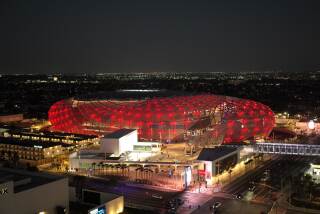William Severns, 88; Los Angeles Impresario
- Share via
William Severns, Los Angeles impresario for six decades who managed the Greek Theatre, the Hollywood Bowl and the Philharmonic and then built the Music Center of Los Angeles County and ran it for 20 years, has died. He was 88.
Severns, who retired from active administration in 1984 but continued to consult for various arts programs around the world, died Dec. 29 in Los Angeles of heart failure.
Rather than creating the music or the drama, Severns spent his life constructing the physical and financial setting where arts could flourish--fueling growth of the performing arts scene in Los Angeles.
Impresarios, as former Times music critic Martin Bernheimer once said, “must be financial wizards, soothsayers, administrative virtuosos, creative mystics, logistics jugglers, psychological masterminds, ego-massagers, performing-baby-sitters, missionary zealots, court jesters, official taste-makers, benign landlords and cultural czars, all at the same delirious time.”
The quiet, modest, self-effacing Severns was all that--a man who could always get things done yet never expected applause for doing it--Bernheimer said when Severns was honored with the Spirit of Los Angeles Award in 1980.
Severns is largely credited with bringing together private and government funding--unheard of in arts circles in the mid-20th century--in the person of fund-raiser Dorothy Buffum Chandler and the Los Angeles County Board of Supervisors to build the Music Center.
“Frankly, nobody thought it could be done,” Severns told The Times in 1989 as the Music Center celebrated its first quarter century. “Not the building.... That was fairly simple. It was the funding.”
Employing all the talents of an impresario outlined by Bernheimer, Severns melded the Westsiders and the Pasadena social elite and government interests to pay for construction and operation of the three-theater complex.
He also began preliminary work toward the Disney Concert Hall, the fourth building in the center, which is now under construction.
But asked what made the Music Center happen, Severns removed himself from the equation, telling The Times emphatically in 1989: “Mrs. Chandler, who got to like raising money ... and the Board of Supervisors.
He praised the county lawmakers, saying no one gave them credit.
“If it hadn’t been for their willingness to set up a joint powers agreement, we’d never have had it ... no matter how much money she raised.”
Severns was born to show business, if not to the front office he came to occupy. He began as a child actor in his parents’ theater stock company in Chicago.
By the time he came to Los Angeles to attend USC, he was so hooked on the performing arts that he became an usher all over town so he could attend the concerts and shows for free.
He ushered at the Hollywood Bowl, the Shrine Auditorium and the Philharmonic Auditorium on Pershing Square, and, after completing his business administration degree, went to work for the Bowl as publicist and house manager.
Severns honed his management skills over the next decade working in various arts administration tasks, including as an accountant for the legendary impresario L.E. Behymer, who brought music and opera to Los Angeles during the 1930s and 1940s.
After six years as general manager at the Greek Theatre, Severns took the reins of the Hollywood Bowl Assn. in 1952.
Eleven years later, he added another hat as chief administrator of the Southern California Symphony Assn., which operated the Los Angeles Philharmonic, then under the baton of Zubin Mehta.
Severns managed both the Bowl and the Philharmonic until 1966, when he merged the two organizations.
Superb “logistics juggler” that he was, Severns also worked for many of those years on building the Music Center’s Dorothy Chandler Pavilion, Ahmanson Theater and Mark Taper Forum.
He served as administrator and then administrator and chief financial officer of the Music Center from its opening in 1964 until his retirement.
The massive project taught Severns so much about theater nuts and bolts--from layout to materials and supplies--that he became a consultant for other theater projects in development. His much-sought advice contributed to the design of the Santa Monica Civic Auditorium, the Orange County Performing Arts Center, the Louise M. Davies Symphony Hall in San Francisco and the Roy Thomson Hall in Toronto, among others.
In retirement, Severns often took on special assignments, such as that of the Community Redevelopment Assn. in 1986 to aid the troubled Los Angeles Theater Center.
He also served on the boards of the American Symphony Orchestra League, Guest Services Inc., the Grand Peoples Company and Associated Presentations of the Music Center.
There are no immediate survivors.
More to Read
The biggest entertainment stories
Get our big stories about Hollywood, film, television, music, arts, culture and more right in your inbox as soon as they publish.
You may occasionally receive promotional content from the Los Angeles Times.










